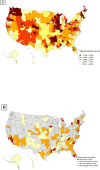Geographic variation and racial disparities in adoption of newer glucose-lowering drugs with cardiovascular benefits among US Medicare beneficiaries with type 2 diabetes
- PMID: 38285682
- PMCID: PMC10824445
- DOI: 10.1371/journal.pone.0297208
Geographic variation and racial disparities in adoption of newer glucose-lowering drugs with cardiovascular benefits among US Medicare beneficiaries with type 2 diabetes
Abstract
Background: Prior studies have shown disparities in the uptake of cardioprotective newer glucose-lowering drugs (GLDs), including sodium-glucose cotranwsporter-2 inhibitors (SGLT2i) and glucagon-like peptide-1 receptor agonists (GLP1a). This study aimed to characterize geographic variation in the initiation of newer GLDs and the geographic variation in the disparities in initiating these medications.
Methods: Using 2017-2018 claims data from a 15% random nationwide sample of Medicare Part D beneficiaries, we identified individuals diagnosed with type 2 diabetes (T2D), who had ≥1 GLD prescriptions, and did not use SGLT2i or GLP1a in the year prior to the index date,1/1/2018. Patients were followed up for a year. The cohort was spatiotemporally linked to Dartmouth hospital-referral regions (HRRs), with each patient assigned to 1 of 306 HRRs. We performed multivariable Poisson regression to estimate adjusted initiation rates, and multivariable logistic regression to assess racial disparities in each HRR.
Results: Among 795,469 individuals with T2D included in the analyses, the mean (SD) age was 73 (10) y, 53.3% were women, 12.2% were non-Hispanic Black, and 7.2% initiated a newer GLD in the follow-up year. In the adjusted model including clinical factors, compared to non-Hispanic White patients, non-Hispanic Black (initiation rate ratio, IRR [95% CI]: 0.66 [0.64-0.68]), American Indian/Alaska Native (0.74 [0.66-0.82]), Hispanic (0.85 [0.82-0.87]), and Asian/Pacific islander (0.94 [0.89-0.98]) patients were less likely to initiate newer GLDs. Significant geographic variation was observed across HRRs, with an initiation rate spanning 2.7%-13.6%.
Conclusions: This study uncovered substantial geographic variation and the racial disparities in initiating newer GLDs.
Copyright: © 2024 Chen et al. This is an open access article distributed under the terms of the Creative Commons Attribution License, which permits unrestricted use, distribution, and reproduction in any medium, provided the original author and source are credited.
Conflict of interest statement
The authors have declared that no competing interests exist.
Figures


Similar articles
-
Social determinants of health and newer glucose-lowering drugs adoption among US Medicare beneficiaries with type 2 diabetes.J Manag Care Spec Pharm. 2024 Nov;30(11):1298-1307. doi: 10.18553/jmcp.2024.30.11.1298. J Manag Care Spec Pharm. 2024. PMID: 39471265 Free PMC article.
-
Association of Race and Ethnicity With Prescription of SGLT2 Inhibitors and GLP1 Receptor Agonists Among Patients With Type 2 Diabetes in the Veterans Health Administration System.JAMA. 2022 Sep 6;328(9):861-871. doi: 10.1001/jama.2022.13885. JAMA. 2022. PMID: 36066519 Free PMC article.
-
Racial and ethnic disparities in the uptake of SGLT2is and GLP-1RAs among Medicare beneficiaries with type 2 diabetes and heart failure, atherosclerotic cardiovascular disease and chronic kidney disease, 2013-2019.Diabetologia. 2025 Jan;68(1):94-104. doi: 10.1007/s00125-024-06321-2. Epub 2024 Nov 8. Diabetologia. 2025. PMID: 39514094 Free PMC article.
-
Racial and Ethnic Disparities in Opioid Prescribing on Hospital Discharge Among Older Adults: A National Retrospective Cohort Study.J Gen Intern Med. 2024 Jun;39(8):1444-1451. doi: 10.1007/s11606-024-08687-w. Epub 2024 Feb 29. J Gen Intern Med. 2024. PMID: 38424348 Free PMC article.
-
Race and Ethnicity Representation in Phase 2/3 Oncology Clinical Trial Publications: A Systematic Review.JAMA Health Forum. 2024 Jun 7;5(6):e241388. doi: 10.1001/jamahealthforum.2024.1388. JAMA Health Forum. 2024. PMID: 38848090 Free PMC article.
Cited by
-
Social and Structural Determinants of Cardiovascular Complications of Diabetes.Curr Diab Rep. 2024 Jul;24(7):147-157. doi: 10.1007/s11892-024-01541-7. Epub 2024 May 2. Curr Diab Rep. 2024. PMID: 38696042 Review.
-
Structural factors and their influence on the use of novel antidiabetic agents: Making the case for increased awareness and access to clinical pharmacy services.J Am Coll Clin Pharm. 2025 Jan;8(1):47-51. doi: 10.1002/jac5.2050. Epub 2024 Nov 28. J Am Coll Clin Pharm. 2025. PMID: 40051646
-
Project ECHO Diabetes Trial Improves Outcomes for Medically Underserved People.Diabetes Care. 2025 Feb 1;48(2):243-250. doi: 10.2337/dc24-2100. Diabetes Care. 2025. PMID: 39688288 Free PMC article. Clinical Trial.
-
Antiretroviral Therapy Use and Disparities Among Medicare Beneficiaries with HIV.J Gen Intern Med. 2024 Sep;39(12):2196-2205. doi: 10.1007/s11606-024-08847-y. Epub 2024 Jun 12. J Gen Intern Med. 2024. PMID: 38865008
-
Health Disparity Clusters of Off Label Prescriptions for Glucagon-Like Peptide 1 Receptor Agonists.Am J Med Open. 2025 Apr 4;13:100100. doi: 10.1016/j.ajmo.2025.100100. eCollection 2025 Jun. Am J Med Open. 2025. PMID: 40496649 Free PMC article.
References
-
- CDC. Type 2 Diabetes. In: Centers for Disease Control and Prevention [Internet]. 2 Mar 2022 [cited 21 Jun 2022]. https://www.cdc.gov/diabetes/basics/type2.html
-
- CDC. Native Americans with diabetes. In: Centers for Disease Control and Prevention [Internet]. 15 Nov 2018 [cited 19 Jun 2022]. https://www.cdc.gov/vitalsigns/aian-diabetes/index.html
Publication types
MeSH terms
Substances
Grants and funding
LinkOut - more resources
Full Text Sources
Medical

